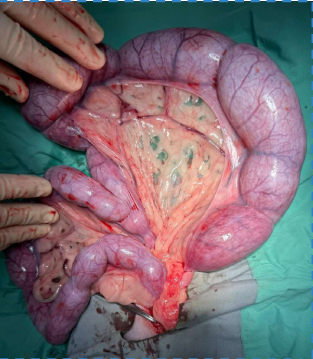
What is Pyometra?
Pyometra is a serious and potentially life-threatening condition affecting the reproductive system of female dogs and cats. It occurs when the uterus becomes infected, leading to the accumulation of pus inside the uterine cavity. The condition is most commonly seen in unspayed females and can manifest in two forms: open pyometra and closed pyometra. Understanding the symptoms, treatment options, and preventive measures for pyometra is crucial for every pet owner.
Symptoms of Pyometra
The signs of pyometra can vary depending on whether the condition is open or closed.
Open Pyometra
In open pyometra, the cervix is open, allowing pus to drain out of the uterus. Symptoms include:
• Vaginal Discharge: The most obvious sign is a thick, purulent discharge from the vagina.
• Increased Thirst and Urination: Pets with pyometra may drink more water and urinate more frequently.
• Vomiting and Diarrhea: These can be signs of systemic infection.
• Lethargy: Affected animals may seem unusually tired or weak.
• Loss of Appetite: Decreased interest in food can be a red flag.
• Abdominal Enlargement: The abdomen might appear swollen or distended.
Closed Pyometra
In closed pyometra, the cervix is closed, trapping pus inside the uterus.
Symptoms are more systemic and may include:
• Abdominal Pain or Distension: The abdomen may feel firm or painful.
• Fever: An elevated body temperature can indicate infection.
• Lethargy and Weakness: A decrease in energy levels.
• Dehydration: Pets may show signs of dehydration due to vomiting or not drinking enough water.
Causes and Risk Factors
Pyometra is most commonly seen in female dogs and cats that have not been spayed. The risk increases with age and multiple heat cycles. The condition is often triggered by hormonal changes during or after estrus (heat). Specifically, high levels of progesterone, which are present during the luteal phase of the heat cycle, contribute to changes in the uterus that predispose it to infection.
Diagnosis of Pyometra
Diagnosing pyometra involves several steps:
1. Physical Examination: A veterinarian will palpate the abdomen for signs of distension or pain.
2. Blood Tests: These can reveal elevated white blood cell counts and other markers of infection.
3. Imaging: X-rays or ultrasounds are used to visualize the uterus and confirm the presence of pus.
4. Vaginal Discharge Examination: For open pyometra, examining the vaginal discharge can provide diagnostic clues.
Treatment Options for Pyometra
Treatment for pyometra is critical and often urgent. The primary treatment methods include:
1. Surgical Treatment (Ovariohysterectomy):
o Procedure: The surgical removal of the uterus and ovaries.
o Effectiveness: This is the most effective treatment and is usually the recommended approach for both open and closed pyometra.
o Recovery: Post-surgery recovery involves a few days to weeks, depending on the pet’s overall health and the intensity of the infection.
2. Medical Management:
o Antibiotics: Used to manage infection temporarily.
o Hormonal Therapy: Medications such as prostaglandins may be used to help expel the pus.
o Supportive Care: Includes fluids, pain management, and monitoring for potential complications.
o Limitations: Medical management is less effective and is typically only recommended for animals that are poor surgical candidates or as a temporary measure.
Prevention of Pyometra
The most effective way to prevent pyometra is spaying, which involves the surgical removal of the uterus and ovaries. This procedure not only prevents pyometra but also eliminates the risk of unwanted pregnancies and reduces the risk of certain cancers.
For those not opting for spaying, regular veterinary check-ups are essential for early detection and management of health issues.
Frequently Asked Questions (FAQ) about Pyometra
1. Can Pyometra Affect Spayed Pets?
No, pyometra cannot occur in spayed pets as the uterus is removed during the spaying procedure. If a spayed pet shows symptoms similar to pyometra, it is important to consult a veterinarian as there might be other underlying issues.
2. How Serious is Pyometra?
Very serious. Pyometra is a medical emergency that requires prompt treatment. Without intervention, it can lead to severe complications such as sepsis, kidney failure, and even death.
3. Can Pyometra Recur After Treatment?
No, once the uterus is removed through spaying, the risk of pyometra is eliminated. However, if a pet was only medically treated for pyometra, there’s a risk of recurrence, especially if hormonal treatments were not effective.
4. How Long Does It Take for a Dog or Cat to Recover from Pyometra Surgery?
Recovery time can vary but generally involves a hospital stay of 1-2 days followed by 1-2 weeks of at-home care. Pets will need to be monitored for signs of complications, and a follow-up visit to the veterinarian is essential.
5. Is Pyometra More Common in Dogs or Cats?
Pyometra is more commonly seen in dogs than in cats, but it can affect both species. Both open and closed pyometra can occur in either species.
6. Can Pyometra Be Treated Without Surgery?
Surgical removal of the uterus and ovaries is the most effective treatment for pyometra. Medical management might be considered in certain cases, but it is less reliable and often only a temporary measure.
7. How Can I Tell if My Pet is in Heat?
Signs of heat in female dogs include increased urination, behavioral changes, and a swollen vulva with a possible blood-tinged discharge. In cats, signs include increased vocalization and affectionate behavior.
